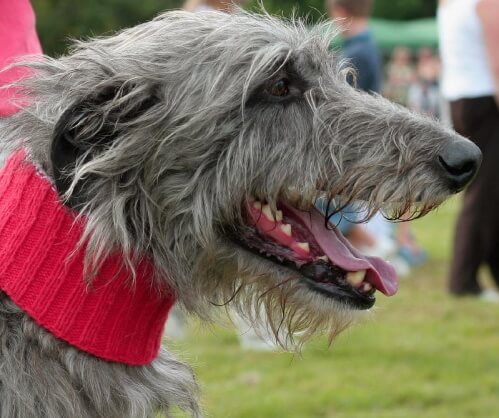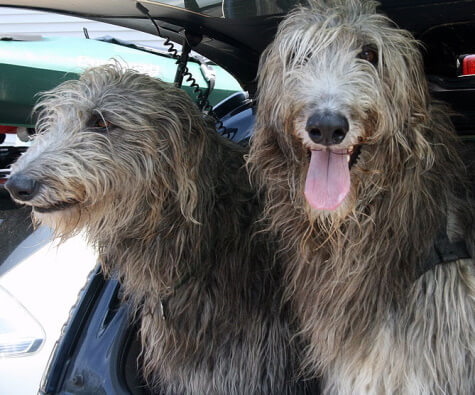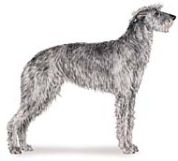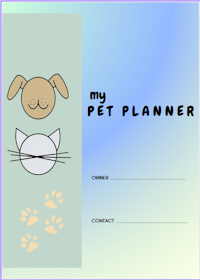Scottish Deer Hound
A Gentle Giant Among Dogs!
The Scottish Deer Hound, a large and powerful sight hound with a history dating back to the 16th century, was bred to hunt red deer in Scotland. It is a modified
version of the ancient wolfhound, its ancestor.
 Image: M.Robinson
Image: M.RobinsonThe hunting expertise of this breed has also been used to hunt Kangaroo
and Wild Boar in Australia, and were at one time also used to track down
wolves in North America.
In its earlier days, the Scottish Deerhound, also known as the Royal Dog of Scotland, resided on the property of large
landowners in Scotland, but during the end of the nineteenth century many
of these estates were broken up and hunting practices changed. Subsequently, the SDH
numbers dwindled. Today the breed is kept mainly as a family dog.
Fame At Last!
A highlight for the breed came about at the 2011 Westminster Dog Show
when judges selected a Scottish Deerhound, namely: GCH Foxcliffe Hickory
Wind, to receive
the prestigious "Best In Show" award. This is the first time this
elegant breed has been so honored.
Characteristics of the Scottish Deer Hound
The Deer Hound's physical prowess and running speed can be likened to
Greyhound, though it is larger and has a long shaggy coat. This longer
coat was no doubt bred in by design, in order to provide the dog with
protection from the harsh weather that prevails in the Scottish
Highlands.
The SDH can out pace the Greyhound over rough ground, but on smooth terrain the Greyhound has the edge.
As for his temperament, the Scottish Deer Hound in an easy going dog that enjoys being part of the family. He is a good-natured fellow, both friendly and dignified.
Very
obedient to his owner and eager to please, but like most hounds, has an independent streak.
Being a quick and intelligent learner,
training can be accomplished with a patient and friendly approach, coupled with consistency and variety.
 Father and Son
Father and SonPhysical Stats And Care
Height: 28-32 inches
Weight: 75-110 lbs.
Color variations: Many dark colors, including blue-gray, gray, and brindle
The Deer Hound's coat is wiry and hard, with a softer beard and brow. Surprisingly, not a great deal of brushing is needed to maintain the coat. Shedding is minimal.
How Active is the Deerhound?
Although a quiet and placid dog inside, once outside it loves to be active.
Needs a lot of room to run, coupled with long walks on leash. Ideal breed for a family that regularly likes to go running and/or hiking.
Ideal Living Space
Apartment life would not be suitable for the Scottish Deer Hound.
House with a fairly big fenced yard to provide some romping room for this
large breed dog, is the ideal environment.

The SDH With Children?
The Scottish Deer Hound has a patient and gentle disposition and is considered a very good breed in families with children that have been taught how to be considerate with pets.
That being said, we always recommend that owners have an adult present when pets and children are interacting - no matter what the breed of dog.
Seniors or Less Active families?
The exercise requirements of the Scottish Deer Hound would not make this breed the best choice for sedentary owners. Active seniors would be an exception.
Health Notes
An extensive amount of health information can be found here at deerhound.org Though the guidance is mainly intended for professional breeders, it is unquestionably recommended reading for anyone considering a deerhound.
Further Reading

Sight Hounds: Their History, Management And Care
Covers history of the Scottish Deer Hound, as well as Afghan Hound, Borzoi, Greyhound, Irish Wolfhound, Saluki and Whippet. Includes practical advice on the care of the breeds from breeding to rearing, grooming, training and general health. Many photos.
Before You Go...
If you like the content of this page, as well as others on my site, please give it some love by clicking on the heart in the lower right hand corner. This helps me to keep providing enjoyable and useful content.
Thank you
Father-Son image: wikimedia.org/wiki/File:Father_and_Son.jpg License CC BY 2.0 M.Robinson image: flickr.com license: NC 2.0

